Uncategorized
Perma-Liner Industries, LLC is hosting an open house in Clearwater, Florida, November 10-12, 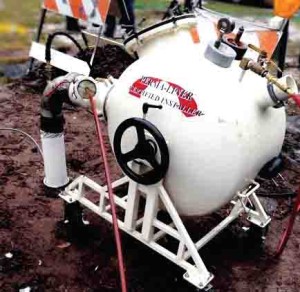 featuring live trenchless pipe repair demonstrations. The installations will be demonstrated in live municipal utilities. Take advantage of one-on-one time with Field Technicians, Sales and Marketing representatives.
featuring live trenchless pipe repair demonstrations. The installations will be demonstrated in live municipal utilities. Take advantage of one-on-one time with Field Technicians, Sales and Marketing representatives.
DEMONSTRATIONS: Continuous Lining Top Gun F-6 & Top Gun F-10, Perma-Lateral™ Lining with Steam and Hot Water Cure, Sectional Point Repair, Pull In Place, Reinstatement Cutters, Cleanout Installation System, Manhole Rehabilitation… and more!
CHRISTMAS IN NOVEMBER: Discounts will be announced during the event and available only to attendees during the 3 day event.
FINANCING: Zero Down, No Payments for 90 Days. Let us show you how to pay for your equipment in 3-4 months! Get pre-approved before the show.
SPECIAL FEATURE: New Technology to be demonstrated exclusively for attendees!
REGISTERED? Call 1-866-336-2568 to confirm your reservation.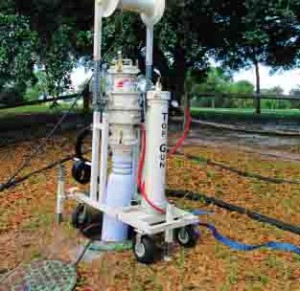
Enter to win an LG TV to be raffled off on November 12 (must be present to win)!
Uncategorized
WASHINGTON, DC — The U.S. Environmental Protection Agency (EPA) recognized the 2015 WaterSense award winners for creating, rebating, communicating and educating consumers about WaterSense-labeled products, homes and programs. These 17 winners and more than 1,700 other WaterSense partners have helped Americans save 1.1 trillion gallons of water and $21.7 billion in water and energy bills since 2006.
WaterSense announced the 2015 Sustained Excellence Award winners, Partners of the Year, and Excellence Award winners today at the WaterSmart Innovations Conference and Exposition in Las Vegas, Nevada.
“EPA is proud to honor these WaterSense partners for making a difference every day in communities across the country,” said Ellen Gilinsky, EPA Office of Water Senior Policy Advisor. “With pervasive droughts on the West Coast and Puerto Rico and water shortages expected in many other parts of the country, these leaders show how water efficiency can make the country more resilient to the effects of our changing climate.”
EPA’s WaterSense program protects the future of our nation’s water supply by offering people a simple way to use less water with water-efficient products, new homes and services. In helping preserve water resources, the important work of the WaterSense program supports the goals of EPA’s Clean Water Rule. Also, because saving water also saves energy, the program supports EPA’s Clean Power Plan, which will help communities save energy and reduce greenhouse gas emissions.
2015 Sustained Excellence Award Winners:
Kohler Co. received the WaterSense Sustained Excellence Award for the third consecutive year for its efficiency efforts in drought-affected areas. These efforts included partnering with The Home Depot in California to offer special promotions on WaterSense labeled products, as well as supporting the Johnson Foundation’s Charting New Waters Initiative to protect water resources across the country. Kohler also promoted WaterSense labeled products at nearly 200 events in 2014 with its “Trust the Flush” bus tour.
Delta Faucet Company earned its first WaterSense Sustained Excellence Award for promoting water efficiency and WaterSense labeled products. Delta collaborated with global hotel chains on studies targeting water efficiency improvements in hotels; worked with major retail chains to develop strategic plans for marketing WaterSense labeled products; and created internationally recognized WaterSense labeled faucets and a smart toilet.
The Home Depot, a three-time Retailer Partner of the Year, received its first Sustained Excellence Award for the significant WaterSense awareness it generated through in-store promotions, information on its own website, and online advertising campaigns, resulting in 518 billion media impressions. For Fix a Leak Week 2014, The Home Depot led a national water efficiency campaign and gave away household kits with WaterSense labeled products.
KB Home was recognized with a WaterSense Sustained Excellence Award for its continued work building WaterSense labeled homes, for which it previously earned Builder Partner of the Year for four years. In addition to building nearly 100 WaterSense labeled homes in 2014, KB Home also constructed model homes in California featuring innovative water-efficient products, along with graywater recycling systems that provide water for toilet-flushing or landscape irrigation.
2015 Partners of the Year:
Promotional Partner of the Year: The City of Charlottesville (Virginia) promoted WaterSense labeled products through a variety of outlets in 2014, including its annual Fix a Leak Week Family 5K race, the Virginia Discovery Museum’s Kid*Vention event, Charlottesville’s Local Energy Alliance Program, and a new “Blue Team” of high school students who distributed water conservation kits door-to-door.
Promotional Partner of the Year: Cobb County (Georgia) Water System’s promotion of every major WaterSense outreach campaign—including the H2Otel Challenge, Shower Better Month, Sprinkler Spruce-Up, and Fix a Leak Week—resulted in its fourth WaterSense Promotional Partner of the Year award. For example, during Shower Better Month in 2014, the utility gave 3,600 WaterSense labeled showerheads to retrofit all of the dormitory restrooms at Kennesaw State University.
Promotional Partner of the Year: Murray City (Utah) Corporation’s Tap Into Murray Quality campaign featured traditional media, along with a traveling event booth, to promote WaterSense labeled products and water-efficient practices to community members. The city also marketed its WaterSense labeled toilet rebate program with the help of local plumbers and plumbing suppliers.
Promotional Partner of the Year: Texas A&M Agrilife Research and Extension Center at Dallas used a Mobile WaterSense Home and dual-flush toilet and irrigation controller demonstrations to educate consumers about WaterSense labeled products at regional events. The Center’s successful Find It, Flag It, Fix It campaign helped homeowners identify irrigation system leaks for Fix a Leak Week 2014.
Manufacturer Partner of the Year: The Toro Company focused on educating contractors and end users about properly installing and programming its WaterSense labeled irrigation controllers through partnerships with water agencies and the Irrigation Association’s regional chapters and distributors.
Licensed Certification Provider Partner of the Year: Energy Inspectors Corporation certified 100 WaterSense labeled new homes in 2014 and continued working with KB Home to build even more communities of WaterSense labeled homes. The company also kept its inspectors’ knowledge current through creation of an online training video on the WaterSense indoor and outdoor criteria for homes.
Professional Certifying Organization Partner of the Year: The Sonoma-Marin (California) Saving Water Partnership, which sponsors the Qualified Water Efficient Landscape (QWEL) professional certification program, accepted four organizations that adopted the QWEL program and certified 200 new irrigation professionals in 2014. The partnership also updated and promoted a graywater training module.
Six Excellence Awards were also given to partners for their efforts in specific WaterSense program areas:
Learn more about the 2015 Sustained Excellence Award winners, WaterSense Partners of the Year, and Excellence Award winners at www.epa.gov/watersense.
Uncategorized
ULC’s Robotic Technology for the Repair and Rehabilitation of Cast Iron Gas Mains is Recognized as a Leading Robotics System in Construction, Mining and Energy by Robotics Business Review
HAUPPAUGE, N.Y., October 5, 2015 – ULC Robotics, Inc. was recognized by Robotics 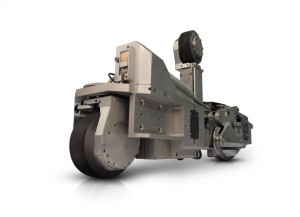 Business Review as a Game Changer Award winner in the Construction, Mining and Energy category for the company’s innovative CISBOT (Cast Iron Joint Sealing Robot) Robotic System. The award recognizes CISBOT for its ability to efficiently rehabilitate large diameter cast iron gas mains with minimal excavation, minimal disruption to the public and without the need to disrupt gas service to local residents and businesses.
Business Review as a Game Changer Award winner in the Construction, Mining and Energy category for the company’s innovative CISBOT (Cast Iron Joint Sealing Robot) Robotic System. The award recognizes CISBOT for its ability to efficiently rehabilitate large diameter cast iron gas mains with minimal excavation, minimal disruption to the public and without the need to disrupt gas service to local residents and businesses.
“ULC is honored and excited to be recognized as one of Robotics Business Review’s Game Changer Award winners,” said Gregory Penza, president and CEO, ULC Robotics, Inc. “With the support of our customers we have been able to make CISBOT a very successful commercial operation and we will continue to develop game changing robotic systems to aid in solving difficult operational and environmental challenges facing the natural gas and energy industries.”
CISBOT operates underground through one small excavation to repair and reinforce joints in cast iron pipelines. CISBOT is revolutionizing the way gas utilities in the US and UK are maintaining these vital assets. The robotic system’s small site footprint and ability to work with virtually no excavation nearly eliminates the public disruption often associated with traditional pipeline repair or replacement. Residential and business gas customers appreciate CISBOT because gas service remains turned on during the procedure.
CISBOT was chosen as a Game Changer by a panel consisting of Robotics Business Review and Robotics Trends editors as well as by distinguished experts from the International Journal of Advanced Robotics Systems (IJARS). Products were judged based on standout attributes, design, functionality, impact and overall benefit to the robotics industry.
To view CISBOT’s Game Changer Award submission and see all Game Changer Award winners please visit www.roboticsbusinessreview.com.
About ULC Robotics, Inc.
ULC Robotics, Inc. is a leader in developing and deploying innovative technology and processes that help pipeline operators and energy companies repair, inspect and assess their infrastructure. The deployment of ULC Robotics’ range of products and services helps to eliminate costly and disruptive excavation while eliminating gas leaks, reducing greenhouse gas emissions and improving efficiency. Both ULC Robotics and their clients have shared accolades for developing some of the most innovative products in the energy industry. Recognition includes a Robotics Business Review 2015 Game Changer Award in Construction, Mining and Energy, 2014 Energy Innovation Award for enabling gas utilities to deliver a safe and reliable supply of energy to customers and inclusion on the 2014 Top 50 Global Robotics Companies by Robotics Business Review. For more information on ULC Robotics, Inc. and its products and services please visit www.ulcrobotics.com
Uncategorized

NASTT turns 25 in 2015! What was happening 25 years ago?
On October 11, 1990, Octavio Paz won Nobel Prize for literature.
On October 14, 1990, SF 49er Joe Montana passed for six touchdowns vs Atlanta (45-35).
On October 17, 1990, Green Day singer Billie Joe Armstrong dropped out of school to pursue a career in music.
Check in every Friday in 2015 when NASTT posts more facts about 25 years ago…
Uncategorized
By Erin Boudreaux, marketing manager, Hobas Pipe USA
In the United States an irrigation district is a cooperative, self-governing public corporation set up as a subdivision of the State government, with definite geographic boundaries, organized and having taxing power to obtain and distribute water for irrigation of lands within the district. It is created under the authority of a State legislature with the consent of a designated fraction of the landowners or citizens. Washington State Water Resources Association (WSWRA) is the coordinating agency for the irrigation districts in Washington State. It includes 35 irrigation district members covering 1.1 million irrigated agricultural acres. 
Naches-Selah Irrigation District (NSID) encompassing 11,000 acres located in north Yakima County, Wash. It is near the towns of Naches and Selah and it serves over 1,700 landowners. The Naches River is a tributary of the Yakima River in central Washington and it is about 75 miles long. After the convergence of the Little Naches and Bumping River the name becomes the Naches River. The Naches and its tributaries drain a portion of the eastern side of the Cascade Range, east of Mount Rainier and northeast of Mount Adams. In terms of discharge, the Naches River is the largest tributary of the Yakima River.
Selah Valley Canal (NSID’s Main Canal) was put into operation in 1892. As with many older systems, replacement was required as the facilities had passed their useful life and continued maintenance and repairs could not guarantee reliable operation. Also, the manually controlled canal system made it a challenge to operate. Selah Valley Canal includes 8,000 feet of wood flumes which are nine feet in diameter as well as concrete canals. Repairs up to this point have included approaches such as placing plywood sheeting over the leaking wood stave flumes. In other cases, where the flumes collapsed, the time required to fix them could be around two weeks. During the watering season, any disruption could be damaging to the crops.
The 2015 Main Canal Flume Replacement and Other Canal Improvements Project was the most recent phase toward the overall modernization and improvement plan. This project has a cost of around $7 million. Between 1910 to1956 the original materials installed in 1892 were improved to the existing wood and concrete facilities and this new phase is an improvement to them.
Replacement of the wood flume trestles was included in the 1995 Comprehensive Water Conservation Plan and again in the 2007 Modernization Plan. The amount of $9 million in capital improvements was completed during 2005 to 2014. “Improvements included canal lining, replacement of some wooden flumes, replacement of wood pipe and open canals with gravity pressurized pipe networks, modern pressurized farm deliveries and canal automation,” said Justin Harter, district manager, Naches-Selah Irrigation District.
The topography of NSID’s service area provides 200 to 300 feet of fall (available head pressure). Deliveries range from minimal pressure up to 40 to 90 PSI depending on the elevation difference from the canal that flows into the pipe networks. Over 3,000 acres have eliminated their need to pump resulting in a power cost savings.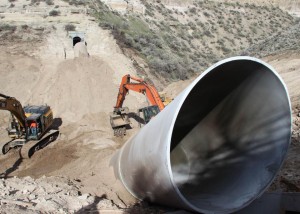
The replacement of 4,600 feet of wood flumes was completed along with 2,800 feet of canal lined with concrete. The wood flumes were replaced with 3,600 feet of centrifugally cast, fiberglass-reinforced, polymer mortar (CCFRPM) pipe with the remaining footage converted into sections of concrete lined canal. The concrete canal sections include a polyethylene lining that is placed under the reinforced concrete that prevents leakage. Hobas Pipe USA supplied 96-inch diameter CCFRPM pipe with a stiffness class of 36 psi.
“A number of pipe materials were considered. Steel pipe required maintenance of coatings with potential to require coating replacement in 50 years or less to manage corrosion. Although higher in initial costs, non-ferrous pipes provide a lower overall cost with a longer lifespan and less maintenance. Hobas was one of the few pipes that could meet the project schedule and performance criteria,” said Harter. Hobas was not intentionally sole sourced, but the higher specification requirements limited competition.
Tapani, Inc. of Battle Ground, Wash., began construction in November 2014 and was finished before the April 1st season start. There is limited time between October and April when the canal is not flowing. “This project had a very tight schedule to meet in order to supply water to the local farms for the 2015 growing season,” said Aaron Halling, project manager, Tapani, Inc.
There were eight wood trestles from heights of five to 75 feet and draws of 20 to 500 feet wide. In this case, a trestle is a rigid frame used as a support, especially referring to a bridge composed of a number of short spans supported by such frames. Many wooden roller coasters are built using design details similar to trestle bridges.
Other sections of wood flume were on grade, resting on existing soils that were leveled 80 or more years ago. “The 96-inch pipe was installed on grades as steep as 50+% and the existing access roads had to be widened in order to get the pipe to the place of installation. Access was limited and delivering to the further locations with off-road equipment took over a half hour per piece of pipe,” said Halling. 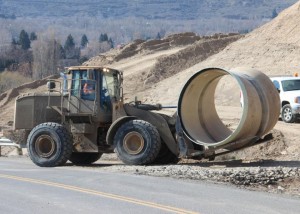
Wood stave flume trestles were replaced with inverted siphons. The large inverted siphons are used to convey water being carried in canals or flumes across valleys for irrigation. With no pump, they are powered by the fall of the water as it flows down the pipe under the pull of gravity, and discharged at a level lower than the surface of where it originated.
The pipe provided to Tapani included factory assembled FWC couplings. Useful for direct bury applications, the FWC coupling is a structural filament wound sleeve overwrapped and mechanically locked to an internal full-face elastomeric membrane. “We faced challenges, but the project was still an overall success and the pipe performed well,” said Halling.
Hobas manufactures pipe in sizes from 18 inches to 126 inches in pressure and non-pressure classes. For more information, please contact Hobas at 800-856-7473, 281-821-2200 or e-mail at info@hobaspipe.com. Facts are also available at www.hobaspipe.com.
Photos information:
Hobas – pipes in a row.jpg
Light weight and easy to handle, the CCFRPM pipe awaits installation in a remote area.
Hobas – siphon.jpg
The existing wood stave flumes were replaced with 96-inch inverted siphons made of HOBAS Pipe.
Hobas – project overview.jpg
Ease of installation allowed Tapani, Inc. to meet the project schedule in time for the start of the 2015 watering season.
Hobas – elbow transport.jpg
Custom fittings were manufactured of the same material as the CCFRPM pipe to meet the design requirements.
Uncategorized
Geotechnical engineer and expert in trenchless technology for water and wastewater conveyance
 Michelle has more than 18 years of experience in geotechnical engineering, with a particular emphasis on trenchless design and involvement in the water/wastewater industry. From a young age, Michelle enjoyed playing in the dirt, solving problems, and helping people. Today, she feels fortunate to have found a career where she can continue to do all three. She brings a passion for assisting the needs of her clients and their trenchless engineering challenges. Jacobs is excited to have her on the team!
Michelle has more than 18 years of experience in geotechnical engineering, with a particular emphasis on trenchless design and involvement in the water/wastewater industry. From a young age, Michelle enjoyed playing in the dirt, solving problems, and helping people. Today, she feels fortunate to have found a career where she can continue to do all three. She brings a passion for assisting the needs of her clients and their trenchless engineering challenges. Jacobs is excited to have her on the team!
Prior to joining Jacobs, Michelle was a senior geotechnical engineer specializing in trenchless design and construction with GeoEngineers and Staheli Trenchless Consultants. Her trenchless expertise includes horizontal directional drilling, microtunneling, pipejacking, auger-boring, pipe ramming, and pilot-tube microtunneling—just to name a few. In addition to her extensive project experience, she has been active in the North American Society for Trenchless Technology (NASTT), is currently a member of the ASCE subcommittee on Trenchless Installation of Pipelines (TIPS), and is a regular presenter at national trenchless conferences.
Since joining Jacobs, Michelle has been assisting on projects across the nation. Some of the more noteworthy endeavors include:
- Two Design/Build efforts for Miami-Dade County Water and Sewer Department (MDWSD) that involve microtunnel crossings of waterways, railways, and congested intersections;
- An HDD project for a 42-inch diameter installation under the St. Johns River for JEA in Jacksonville, Florida;
- Multiple trenchless projects in Texas for the City of Temple and the City of Austin for water distribution and sanitary sewer projects; and
- The I4 Ultimate project in Orlando, where she is providing senior-level QA/QC for trenchless aspects.
Having spent most of her professional career in the Pacific Northwest, Michelle is thrilled to be able to expand her trenchless expertise to other regions. She finds it exciting to work with regional Jacobs offices that offer experience with local agencies and knowledge of local geology. Michelle is able to share her trenchless technology expertise (risks, benefits, and challenges of trenchless options) with Jacobs engineers across the nation, which ultimately provides clients and owners with the best combination of local knowledge and national experience.
For further information please contact:
Michelle Macauley – michelle.macauley@jacobs.com
 featuring live trenchless pipe repair demonstrations. The installations will be demonstrated in live municipal utilities. Take advantage of one-on-one time with Field Technicians, Sales and Marketing representatives.
featuring live trenchless pipe repair demonstrations. The installations will be demonstrated in live municipal utilities. Take advantage of one-on-one time with Field Technicians, Sales and Marketing representatives.







